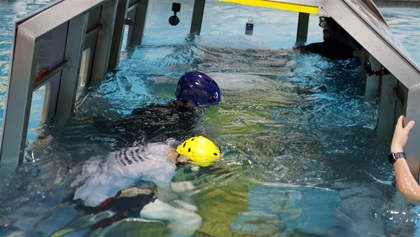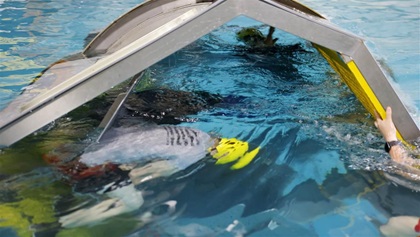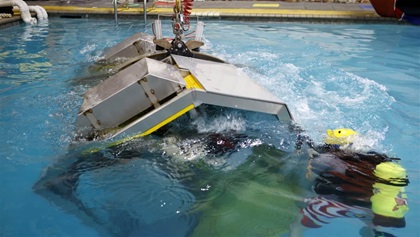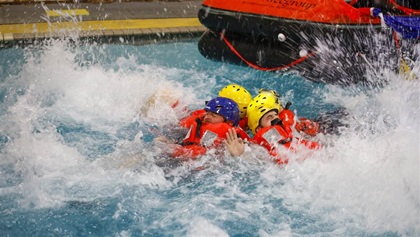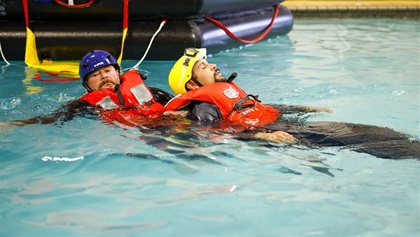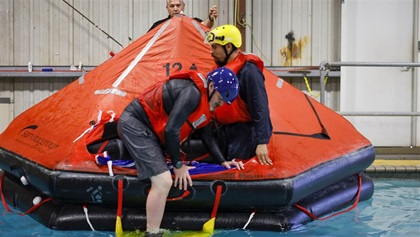‘Need to escape’
Egress training to prepare for the worst

Rose has probably flown more hours, and in more types and models, than even the most seasoned general aviation pilot in his nearly 30 years with the association, and he has hours of instruction under his belt. While the need to pilot the aircraft is not necessary for Rose to accomplish the acclaimed photography and videography he produces for AOPA Media, the question of could he escape a bad situation is a reality. So it was no surprise that when the opportunity to experience a ditching and water egress training was offered, Rose donned his bathing trunks and splashed down.
“I spend a lot of time in small airplanes, flying over water, in seaplanes and it [egress training] is something I’ve always thought I could benefit from, and I finally got to do it,” Rose said.
As his friend and colleague, I found his training almost impossible to watch. Seated and belted in a Triton Simulator with a helmet and personal flotation device, Rose had a second to take his breath before the device rolled forward into the 15-foot-deep pool and water engulfed the simulator. Then he and another participant worked to escape the capsized capsule, modified from a helicopter configuration to mimic a seaplane—the seats turned 90 degrees to demonstrate a forward roll (a helicopter would typically capsize on its side).
We are in Houma, Louisiana, at the site of FMTC (Fire and Medical Training Center), a Netherlands-based training company that specializes in safety training for offshore, maritime, and wind industries. The Houma location is the only one in the United States; FMTC also has locations in Saudi Arabia and France. The part of the four-hour course Rose took is unique to the Houma location. The AUET (aircraft underwater escape training) course was developed along with Southern Seaplane in New Orleans as part of its Seaplane Safety Training course (see “Down on the Bayou,” p. 50). HUET is the helicopter underwater escape training; it is the more commonly taken course at FMTC.
Safety Instructor Thane Markcusen took Rose through an abbreviated AUET (he pronounced it “A-youit”) course that includes three ditching scenarios and some of the company’s sea survival tips. The simulator first fell straight down into the water and Rose had to exit through a window. Next, the simulator fell into the water and Rose exited through the door. Finally, the simulator capsized tail over nose—the most common airplane ditching—and Rose exited while upside down.
“Capsizing is the most disorienting,” Markcusen said.
Rose agreed. “At first it was easy but then it was super challenging; it was disorienting and that need to escape really takes over and you’re focused on getting out of there.”
The course typically takes four hours—two in theory and two in practicaltraining. Participants spend time in the 31-foot by 46-foot pool of chilly water, suspended in the simulator and outfitted in U.S. Coast Guard Type 3 or Type 4 PFDs, said Kaylab Verdin, center manager for Houma. Most participants are helicopter pilots and workers on oil rigs and other overwater industries including wind turbines. Verdin says FMTC is the market leader in water safety training for oil, gas, wind, and marine construction.
The Houma location is the former site of On-Site Training & Instruction, a company started in 1989 by Winona “Bebe” McElroy, Houma’s first female firefighter and a tireless advocate for safety training. Prior to merging with FMTC, McElroy lived in an apartment above the training facility. She is now retired.
“Anybody who does any degree of seaplane flying or flying over water a lot like in Florida or the Great Lakes should consider taking this course or a course like it,” Rose said. “I like to think it would help me if the unfortunate situation ever happened where we went into the water. I feel a little bit better prepared for it.”
“Some plan is better than no plan,” said Markcusen.
FMTCsafety.com
PRICE: $200


